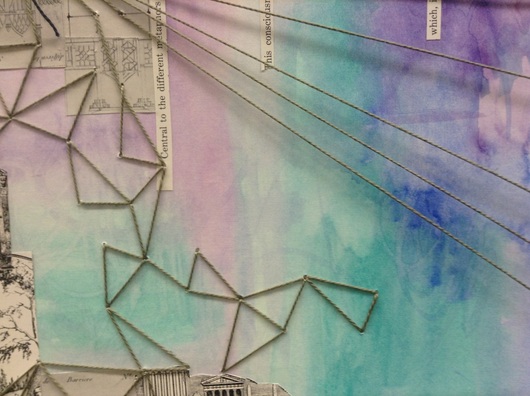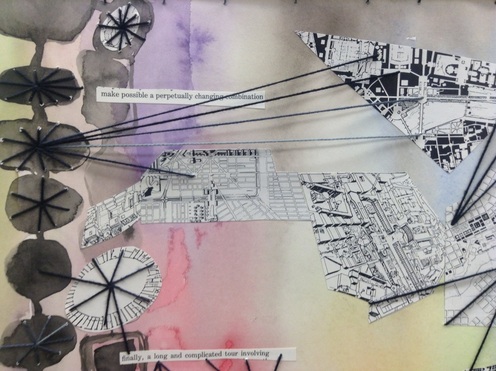Student Teaching Seminar: Final Project
In this section I present my final project for the Student Teaching Seminar. (With the instructor's permission) I have adapted the assignment to align with a project I am currently working on. First, I will present a summary of an article I have selected that aligns with my theme. Next, I will outline my Alternative Teaching Model. I have added images of my Mixed Media work to provide a visual counterpoint to my text.
GUYOTTE, K. W., SOCHACKA, N. W., COSTANTINO, T. E., WALTHER, J., & KELLAM, N. N. (2014). STEAM as Social Practice: Cultivating Creativity in Transdisciplinary Spaces. Art Education, 67(6), 12-19.
 Watercolor, Embroidery thread, Vintage Architecture Journal. Mixed Media by Nandita Baxi Sheth 2014
Watercolor, Embroidery thread, Vintage Architecture Journal. Mixed Media by Nandita Baxi Sheth 2014
Note: You may download the PDF of the article by clicking on the article title above. This article begins by connecting the current social practice missions of the STEAM movement,(which is to add the Arts to STEM (Science, Technology, Engineering and Math) curriculum) with engineering conceived of as social practice. Social Practice may be defined as art and community works that engage publics, are collaborative and are transdisciplinary. This definition is borrowed from the Art and Social Practice Journal. The authors describe the process and outcomes of a Transdisciplinary Design Studio which involved collaboration between engineering, landscape architecture, art education students and interdisciplinary faculty. They describe the concept of transdisciplinarity with the visual metaphor of a, "watercolor painting in which colors bleed together and blur the boundaries between disciplines, and where vibrant new colors reflect the importance of these emergent spaces (p. 14)". The texts for the course were Sparks of Genius (Root-Bernstein, Robert and Michele, 1999) and Are Your Lights On? (Gause and Wienberg, 1990). The texts provided a common vocabulary to link students from diverse backgrounds as they first explored the challenge of waste and water sustainability. The conceptual visual explorations of the students were displayed in a gallery exhibition. In a second challenge students were tasked with moving from the conceptual to actually planning and implementing a community initiative related to water ethics. The authors describe this second challenge as "social practice as doing" in which a framework emerged of "Thinking Through Materials, Considering Audience, and Engaging with Community (p. 17)". The students growth in these three areas is described through interviews, journal entries and images of their final exhibition. The authors found that students learned through experience in the spirit of philosophers John Dewey and Maxine Greene. They offer this framework as a valuable approach to STEAM education which is already structured to offer transdisciplinary and collaborative approaches to problem solving. Additionally the skills of empathy and reflection gained through community engagement allowed students from a variety of disciplines to experience creating as social practice. This article was valuable to my research in that it provided a vision of STEAM as socially engaged practice integrated with art making and problem solving. The article presents a model of collaborative learning and working across disciplines that showed how STEAM learning spaces could function in a real life example. While the article I reviewed describes a university level course and my alternative teaching model will focus on a different cohort of students; the article did provide a strong theoretical and practical framework for thinking about my model which I describe next.
Alternative Teaching Model: 1000 Steps
 Watercolor, Embroidery Thread, Vintage Architecture Journal. Mixed Media by Nandita Baxi Sheth 2014
Watercolor, Embroidery Thread, Vintage Architecture Journal. Mixed Media by Nandita Baxi Sheth 2014
I begin this section by describing the emergence of my model from paying attention to the shifts and intensities of experience. The concept for my alternative teaching model begins with my journey, both physical and intellectual, in between spaces of learning and teaching, in the watery mingling of praxis. Everyday of my student teaching placement at Hughes I parked near DAAP and walked approximately 1000 steps to Hughes High School. I walked.....
- 1000 steps from being student to being teacher.
- 1000 steps from theory to practice.
- 1000 steps from Art School to Technical School
- 1000 steps from one world to another
 Watercolor, Embroidery Thread, Vintage Architecture Journal. Mixed Media by Nandita Baxi Sheth 2014
Watercolor, Embroidery Thread, Vintage Architecture Journal. Mixed Media by Nandita Baxi Sheth 2014
The format of my alternative teaching model is an eight week, once a week, after school activity; which allows for experimentation, reflection, and adaptation on the part of the instructors that can be applied to the next 8 week session. The format is "low stakes" in that the commitment of resources is relatively low and sets the stage for future imaginings and expansions of the program. The after school format allows for student choice (the activity is not required, therefore students will have to commit to participate) and provides an alternative to technique focused art courses.
The central focus of the first session will be empathy, a core value of Hughes HS, which will be experienced through collaborative making. Students, through a series of individual and group 2d and 3d art making ventures, will learn and engage in a variety of art making processes. Throughout the eight weeks, students will also engage in "slow looking" at a sculpture on the UC Campus and a be introduced to variety of informal and formal critique activities which will create opportunities for the development of reflective and mindfulness behaviors. Finally, in planning and considering the exhibition of their works at the end of each session, students will learn about the activity of curating and consider how to engage the public.
The central focus of the first session will be empathy, a core value of Hughes HS, which will be experienced through collaborative making. Students, through a series of individual and group 2d and 3d art making ventures, will learn and engage in a variety of art making processes. Throughout the eight weeks, students will also engage in "slow looking" at a sculpture on the UC Campus and a be introduced to variety of informal and formal critique activities which will create opportunities for the development of reflective and mindfulness behaviors. Finally, in planning and considering the exhibition of their works at the end of each session, students will learn about the activity of curating and consider how to engage the public.